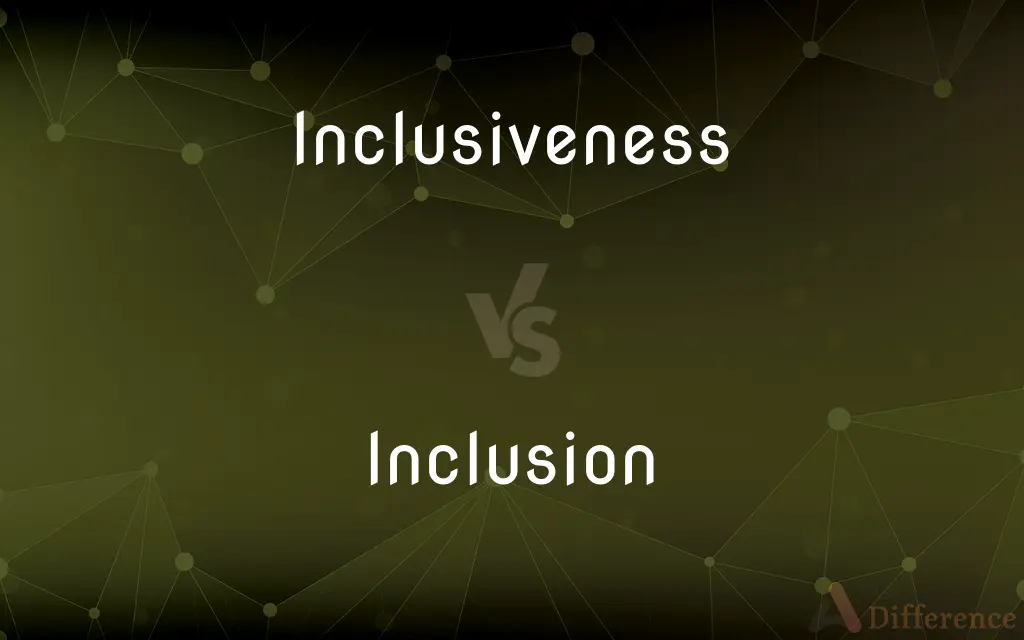Inclusiveness vs. Inclusion — What's the Difference?
By Urooj Arif & Maham Liaqat — Updated on April 1, 2024
Inclusiveness is the quality of covering or considering all aspects and not excluding any part of the society, whereas inclusion refers to the act or policy of including people who might otherwise be excluded or marginalized.

Difference Between Inclusiveness and Inclusion
Table of Contents
ADVERTISEMENT
Key Differences
Inclusiveness is an attribute or approach characterized by an openness and willingness to embrace diversity across all spectrums, including but not limited to, race, gender, disability, and religion. It implies a proactive effort to ensure that environments, systems, or policies are designed to be welcoming and accommodating to all. On the other hand, inclusion is the practical implementation of inclusiveness; it's about taking specific actions or adopting policies that ensure individuals or groups are not left out or marginalized.
Inclusiveness can be seen as a broader principle or philosophy that guides how organizations, communities, and societies aim to recognize and value diversity. It's about setting a tone or creating a culture that naturally leans toward accepting and celebrating differences among people. Whereas inclusion is about the tangible steps taken to translate the ethos of inclusiveness into real-world practices, ensuring that everyone has equal access to opportunities and resources.
While inclusiveness focuses on the intent and efforts to be open and accepting, inclusion is more about the outcomes and impacts of these efforts. For example, a company might have an inclusiveness policy that emphasizes the importance of diversity in the workplace. However, the actual inclusion measures—like hiring practices, workplace accommodations for people with disabilities, and support for employees from diverse backgrounds—determine how effectively this policy is implemented.
In the context of social policy, inclusiveness refers to the overarching goal of creating a society where every individual feels valued and part of the community, regardless of their background or circumstances. Inclusion, in this sense, refers to the specific programs, initiatives, and laws that are put in place to achieve this goal, such as affirmative action programs, anti-discrimination legislation, and community outreach programs.
Both inclusiveness and inclusion are crucial for achieving equity and diversity in any setting. However, inclusiveness without action towards inclusion can result in superficial commitments that don't lead to meaningful change. Conversely, attempts at inclusion without a genuine spirit of inclusiveness might fail to create the intended welcoming environment or might not be sustainable in the long term.
ADVERTISEMENT
Comparison Chart
Definition
The quality of being open to all, not excluding any part of society.
The act or policy of including people who might otherwise be excluded.
Focus
Philosophy and approach.
Practical implementation and actions.
Scope
Broad, encompassing intent and efforts.
Specific, focusing on outcomes and impacts.
Examples in Practice
Adopting principles that value diversity.
Implementing programs that ensure access to opportunities.
Outcome
Aims to create a welcoming culture.
Ensures individuals feel included and valued.
Compare with Definitions
Inclusiveness
Quality of being open.
The organization's inclusiveness was evident in its diverse hiring policies.
Inclusion
Policy of non-exclusion.
The school's inclusion policy facilitated the integration of students with disabilities.
Inclusiveness
Welcoming diversity.
Inclusiveness in education means adapting teaching methods to all learning styles.
Inclusion
Ensuring access to opportunities.
Inclusion in the tech industry means actively recruiting women and minorities.
Inclusiveness
Philosophy guiding actions.
A commitment to inclusiveness influenced the company's global expansion strategy.
Inclusion
Act of including marginalized groups.
Inclusion in the workplace involves providing equal opportunities for advancement.
Inclusiveness
Broad approach to diversity.
Inclusiveness at the festival ensured programming appealed to a wide array of cultural interests.
Inclusion
Practical steps towards equality.
Their inclusion initiative included mentorship programs for minority employees.
Inclusiveness
Proactive effort to embrace all.
Their inclusiveness strategy involved outreach to underrepresented communities.
Inclusion
Outcome of inclusiveness efforts.
The result of their inclusiveness was a significant increase in team inclusion and diversity.
Inclusiveness
The quality of covering or dealing with a range of subjects or areas
The most useful feature of the book is probably its inclusiveness
Inclusion
The action or state of including or of being included within a group or structure
They have been selected for inclusion in the scheme
Inclusiveness
Taking a great deal or everything within its scope; comprehensive
An inclusive survey of world economic affairs.
Inclusion
A body or particle of distinct composition embedded in a rock or other material.
Inclusiveness
Including the specified extremes or limits as well as the area between them
The numbers one to ten, inclusive.
Inclusion
The act of including or the state of being included.
Inclusiveness
(Linguistics) Of, relating to, or being a first person plural pronoun that includes the addressee, such as we in the sentence If you're hungry, we could order some pizza.
Inclusion
Something included.
Inclusiveness
The property of being inclusive; inclusivity
Inclusion
A solid, liquid, or gaseous foreign body enclosed in a mineral or rock.
Inclusion
A nonliving mass, such as a droplet of fat, in the cytoplasm of a cell.
Inclusion
(Computers) A logical operation that assumes the second statement of a pair is true if the first one is true.
Inclusion
(countable) An addition or annex to a group, set, or total.
The poem was a new inclusion in the textbook.
Inclusion
(uncountable) The act of including, i.e. adding or annexing, (something) to a group, set, or total.
The inclusion of the poem added value to the course.
Inclusion
(countable) Anything foreign that is included in a material,
Inclusion
Any material that is trapped inside a mineral during its formation, as a defect in a precious stone.
Inclusion
(cytology) A nuclear or cytoplasmic aggregate of stainable substances.
Inclusion
(histology) An object completely inside a tissue, such as epidermal inclusion cyst, a cyst in the epidermis.
Inclusion
(mathematics) A mapping where the domain is a subset of the image.
Inclusion
(obsolete) Restriction; limitation.
Inclusion
The act of including, or the state of being included; limitation; restriction; as, the lines of inclusion of his policy.
Inclusion
Something that is included.
Inclusion
A foreign substance, either liquid or solid, usually of minute size, inclosed in the mass of a mineral.
Inclusion
A small body suspended within the cytoplasm of a cell.
Inclusion
The relationship existing between two sets if one is a subset of the other.
Inclusion
The state of being included
Inclusion
The relation of comprising something;
He admired the inclusion of so many ideas in such a short work
Inclusion
Any small intracellular body found within another (characteristic of certain diseases);
An inclusion in the cytoplasm of the cell
Inclusion
The act of including
Common Curiosities
Why is inclusiveness important?
Inclusiveness is important because it fosters an environment where all individuals feel valued and recognized, contributing to a healthier, more productive society.
Can there be inclusiveness without inclusion?
While inclusiveness can exist as a principle or philosophy without immediate action, it requires concrete steps towards inclusion to be effective and meaningful.
How can an organization implement inclusion?
Organizations can implement inclusion through diverse hiring practices, inclusive workplace policies, training programs, and by fostering an environment that celebrates diversity.
How does inclusiveness relate to diversity?
Inclusiveness is a philosophy that underpins diversity efforts, ensuring that diversity is not only acknowledged but embraced and celebrated.
Is inclusion only a workplace issue?
No, inclusion applies to all areas of society, including education, healthcare, politics, and community life, ensuring everyone has equal access and opportunities.
Can inclusiveness lead to better outcomes for businesses?
Yes, businesses that embrace inclusiveness and diversity report better financial performance, greater innovation, and higher employee satisfaction.
How can inclusiveness be measured?
Inclusiveness can be measured through surveys assessing attitudes and perceptions, diversity metrics, and evaluating the effectiveness of inclusion policies.
What are the benefits of inclusion?
Benefits of inclusion include increased innovation, improved employee satisfaction and loyalty, broader perspectives, and better decision-making.
What role do leaders play in fostering inclusiveness?
Leaders play a crucial role in setting the tone for an inclusive culture by modeling inclusive behavior, making commitments to diversity, and implementing policies that support inclusion.
How can communities become more inclusive?
Communities can become more inclusive by engaging in open dialogues, supporting inclusive policies and programs, and ensuring equitable access to community resources.
What challenges might organizations face in implementing inclusiveness and inclusion?
Challenges include overcoming unconscious biases, resistance to change, and ensuring inclusion practices are embedded in all areas of the organization.
How does social media impact inclusiveness and inclusion?
Social media can both positively and negatively impact inclusiveness and inclusion, depending on how it's used to amplify diverse voices or, conversely, spread exclusionary messages.
What is the difference between inclusion and equality?
Inclusion focuses on ensuring everyone has access to the same opportunities, while equality aims at ensuring everyone receives the same treatment and outcomes.
What role does education play in promoting inclusiveness and inclusion?
Education is critical in promoting inclusiveness and inclusion by teaching values of diversity, empathy, and respect from an early age.
How do inclusiveness and inclusion relate to equity?
Inclusiveness and inclusion are steps towards achieving equity, which is about ensuring fair treatment, access, and opportunity for all, recognizing and making adjustments for inequalities.
Share Your Discovery

Previous Comparison
Bitumen vs. Pitch
Next Comparison
Referral vs. ReferrerAuthor Spotlight
Written by
Urooj ArifUrooj is a skilled content writer at Ask Difference, known for her exceptional ability to simplify complex topics into engaging and informative content. With a passion for research and a flair for clear, concise writing, she consistently delivers articles that resonate with our diverse audience.
Co-written by
Maham Liaqat













































